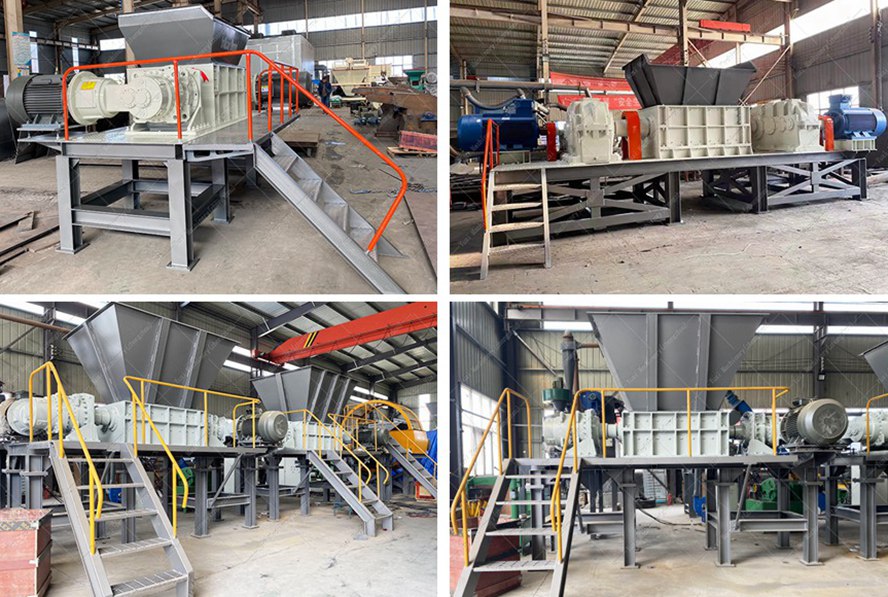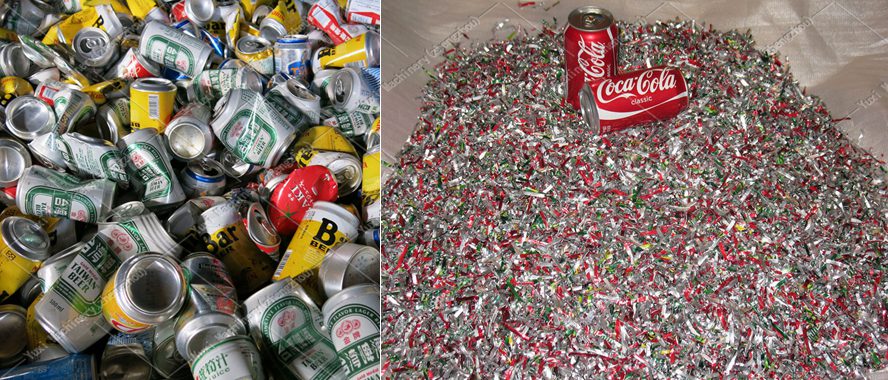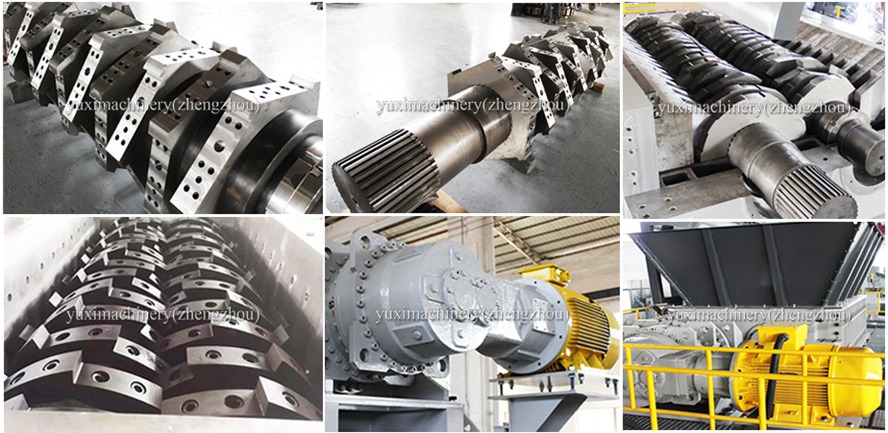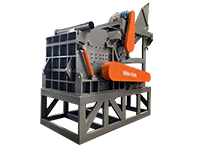I. Core Value of Can Shredders: An Efficient Solution for Industrial Waste Disposal
In food processing, resource recycling, and other fields, can shredders are key equipment for processing rigid packaging such as metal/aluminum cans and tin cans. Through professional shredding technology, they realize volume reduction, separation, and resource treatment of waste packaging, solving the problems of low efficiency, high cost, and heavy pollution of traditional manual processing.
The core principle of a can shredder is a combined technology of "shearing + extrusion + grinding": the built-in high-strength blade set first tears the can, then the extrusion module flattens it, and finally the grinding system crushes it into uniform small pieces. At the same time, a screening device is equipped to separate the metal can body from residual contents and liquids, creating conditions for subsequent resource recycling.
For enterprises, the value of can shredders is reflected in three dimensions:
• Cost Reduction: Compress the volume of waste to 1/5-1/10 of its original size, significantly reducing storage and transportation costs;
• Efficiency Improvement: Realize fully automatic processing without manual sorting, with a processing efficiency more than 10 times that of manual work;
• Environmental Protection: Avoid pollution caused by rust and liquid leakage of waste cans, while improving metal recovery rates.

1. Efficient Volume Reduction to Compress Waste Volume
Through the cooperation of high-speed rotating blades and extrusion modules, can shredders can quickly compress the volume of metal cans and tin cans. Aluminum tin cans can be transformed from their original cylindrical shape into metal sheets with a thickness of only 0.08-0.12 inches, while tin cans will be crushed into 2-4 inch pieces. The overall volume is reduced by 80%-90%, greatly saving storage space.
2. Material Separation to Achieve Classified Resource Recycling
The built-in screening system of the equipment automatically separates metal fragments from residual food and liquids during the shredding process: metal fragments enter the recycling channel through the discharge port, while liquids and organic residues flow into a special collection tank for subsequent separate treatment, avoiding the impact of mixed materials on recycling value.
3. Safe Processing to Avoid Risks of Manual Operation
The closed shredding cavity is matched with an automatic feeding system, so that operators do not need to directly contact the sharp edges of cans, avoiding safety accidents such as scratches and cuts. At the same time, the equipment is equipped with an overload protection device, which will automatically stop when the feeding volume is too large to prevent equipment damage and material blockage.
4. Multi-Material Adaptation to Meet Needs of Different Scenarios
By adjusting the blade gap and equipment speed, can shredders can process packaging of various materials:
• Aluminum tin cans: Adopt high-speed shearing mode for quick tearing and flattening;
• Tin cans: Switch to heavy-duty extrusion mode to handle rigid metals;
• Plastic composite cans: Adjust the blade gap to avoid plastic adhesion;
• Small metal barrels: Turn on the grinding auxiliary function to achieve uniform crushing.
5. Low-Energy Operation to Control Processing Costs
Modern can shredders are equipped with intelligent load sensing technology, which automatically adjusts power according to the feeding volume to avoid idling waste. At the same time, wear-resistant alloy blades are used, with a service life of more than 13,000 hours, reducing the frequency and cost of blade replacement, and making the energy consumption per ton of materials 40% lower than that of traditional equipment.
III. Analysis of Energy Consumption and Costs of Can Shredders
1. Composition of Energy Consumption
The energy consumption of can shredders mainly comes from three parts:
• Motor Power: The motor power of small equipment is usually 4-7HP, and that of large equipment is 20-30HP. The power consumption per hour of operation is about 3-22kWh;
• Auxiliary Systems: The energy consumption of auxiliary systems such as dust collection and liquid recovery accounts for about 15%-20% of the total energy consumption;
• Standby Loss: For equipment equipped with intelligent standby functions, standby energy consumption can be controlled within 5% of the total energy consumption, which is 10% lower than that of ordinary equipment.
2. Cost Breakdown
• Procurement Cost: Small models cost about $1,500-$38,000, medium models cost $38,000-$100,000, and large models cost $100,000-$250,000;
• Maintenance Cost: The annual maintenance cost for blade replacement, lubricating oil, etc. is about 5%-8% of the equipment procurement price;
• Operation Cost: The processing cost per ton of materials (including electricity and labor) is about $9-$18, which is more than 60% lower than manual processing.

IV. Key Points for Purchasing Can Shredders
1. Capacity Matching
Select the equipment model according to the daily processing volume, and it is recommended to reserve 20% redundant capacity:
• Daily processing volume within 1100lbs: Select small equipment with 1100-2200lbs/hour;
• Daily processing volume of 2200-6600lbs: Select medium equipment with 3300-6600lbs/hour;
• Daily processing volume of more than 6600lbs: Select large equipment with more than 8800lbs/hour.
2. Material Adaptation
• For mainly processing aluminum tin cans: Prioritize "high-speed shearing type" shredders with a blade speed ≥1200RPM;
• For mainly processing tin cans: Select "heavy-duty extrusion type" equipment with blades with a thickness of more than 0.63 inches;
• For mixed processing of multiple materials: Select "multi-functional adjustable type" that supports blade gap and speed adjustment.
3. Environmental Protection Configuration
• For processing cans with liquids: Select equipment with liquid collection tanks and anti-corrosion cavities;
• For processing materials that are prone to dust generation: Select models with dust collection systems with a dust filtration efficiency ≥99%;
• For meeting strict environmental protection standards: Select equipment with noise reduction devices with an operating noise ≤85dB(A).
4. Maintenance Convenience
• Select equipment with quickly replaceable blades, with a replacement time ≤30 minutes;
• Prioritize models with intelligent fault alarm functions that can real-time prompt blade wear, cavity blockage, etc.;
• Check the supply of vulnerable parts of the equipment to ensure sufficient accessories for subsequent maintenance.
V. Guide for Using and Maintaining Can Shredders
Usage Precautions
1. Feed Pretreatment: Remove foreign objects such as glass shards and stones from the cans to avoid damaging the blades;
2. Feed Control: Feed according to the rated speed of the equipment, and the single feeding volume does not exceed 70% of the cavity capacity;
3. Operation Monitoring: Do not open the cavity when the equipment is running, and regularly check the material status at the discharge port to ensure no blockage;
4. Shutdown Operation: Stop feeding first, and shut down after the materials in the cavity are completely discharged to avoid jamming when starting next time.
Daily Maintenance Points
1. Daily Inspection: Check the wear of the blades before starting up, and clean the residual materials at the feed and discharge ports;
2. Weekly Maintenance: Clean the filter screen of the screening system, check the tightness of the belt, and adjust it to the appropriate tension;
3. Monthly Maintenance: Replace the lubricating oil of the gearbox, check whether the screws of the equipment are loose, and tighten key parts;
4. Quarterly Overhaul: Disassemble the blades for grinding or replacement, and check the operating temperature of the motor to ensure no abnormalities.
VI. Frequently Asked Questions (FAQ)
1. Can can shredders process cans with liquids?
Yes. Models with liquid collection tanks will automatically separate liquids, and the anti-corrosion cavity can avoid damage to the equipment by liquids.
2. Can the crushed metal fragments be directly recycled?
Yes. The metal fragments output by standard-compliant can shredders can enter the metal recycling process after simple magnetic separation/wind separation.
3. Are can shredders suitable for small businesses?
Yes. Currently, there are small models with a daily processing volume of 1100lbs on the market, which are moderately priced and can quickly recover processing costs.
4. Will the noise of can shredders affect production?
Formal models are equipped with sound insulation covers, and the operating noise can be controlled within 85dB(A), which meets the noise standards of industrial sites.
5. Can plastic cans be processed with metal can shredders?
Some multi-functional models support this, but special blades need to be replaced. It is recommended to confirm material compatibility with the manufacturer in advance.

VII. Summary: Can Shredders—"Standard Tools" for Industrial Waste Disposal
From volume reduction and cost reduction to resource recycling, from safe processing to multi-scenario adaptation, can shredders have become "standard tools" for food processing and resource recycling enterprises. They can not only solve the problem of waste can disposal but also create additional recycling benefits for enterprises through efficient resource utilization.
When selecting a aluminium can shredder, it is necessary to combine its own processing volume, material type, and environmental protection needs, and prioritize models with matching capacity, convenient maintenance, and low energy consumption. At the same time, proper daily use and maintenance can extend the service life of the equipment by more than 30% and further reduce long-term operating costs.
For enterprises pursuing cost reduction, efficiency improvement, and environmental compliance, a suitable can shredder is both a "sharp tool" for waste disposal and a "bridge" for improving resource utilization.
 Shredding Machine
Shredding Machine
 Waste Recycling Line
Waste Recycling Line
 Optional Equipment
Optional Equipment



